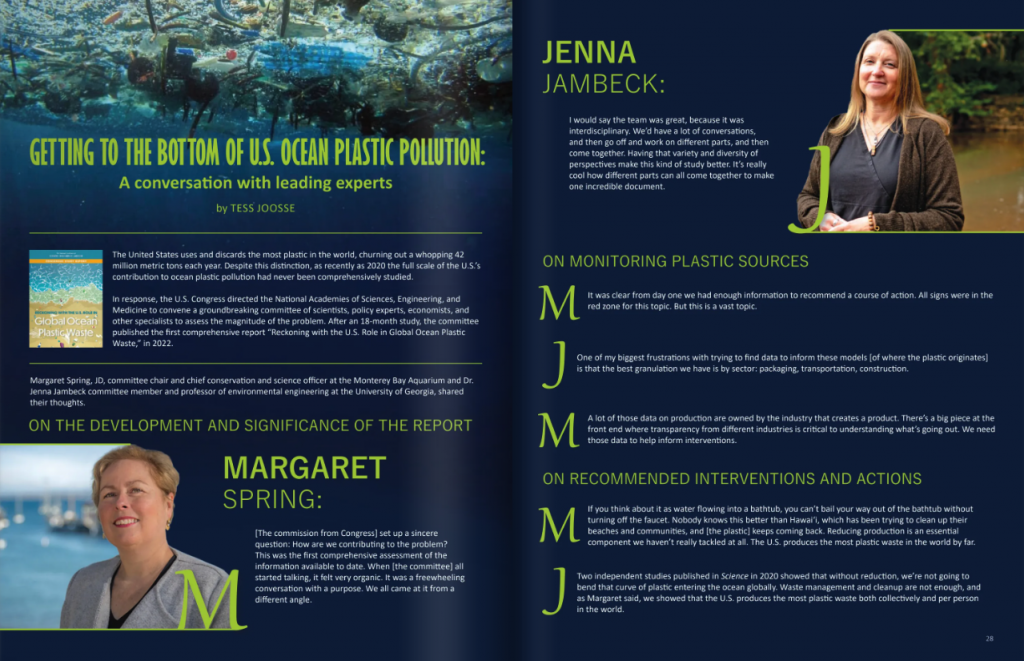The United States uses and discards the most plastic in the world, churning out a whopping 42 million metric tons each year. Despite this distinction, as recently as 2020 the full scale of the U.S.’s contribution to ocean plastic pollution had never been comprehensively studied.
In response, the U.S. Congress directed the National Academies of Sciences, Engineering, and Medicine to convene a groundbreaking committee of scientists, policy experts, economists, and other specialists to assess the magnitude of the problem. After an 18-month study, the committee published the first comprehensive report “Reckoning with the U.S. Role in Global Ocean Plastic Waste,” in 2022.
Margaret Spring, JD, committee chair and chief conservation and science officer at the Monterey Bay Aquarium and Dr. Jenna Jambeck committee member and professor of environmental engineering at the University of Georgia, shared their thoughts.
Margaret Spring (MS): [The commission from Congress] set up a sincere question: How are we contributing to the problem? This was the first comprehensive assessment of the information available to date. When [the committee] all started talking, it felt very organic. It was a freewheeling conversation with a purpose. We all came at it from a different angle.
Jenna Jambeck (JJ): I would say the team was great, because it was interdisciplinary. We’d have a lot of conversations, and then go off and work on different parts, and then come together. Having that variety and diversity of perspectives make this kind of study better. It’s really cool how different parts can all come together to make one incredible document.
On Monitoring Plastic Sources
MS: It was clear from day one we had enough information to recommend a course of action. All signs were in the red zone for this topic. But this is a vast topic.
JJ: One of my biggest frustrations with trying to find data to inform these models [of where the plastic originates] is that the best granulation we have is by sector: packaging, transportation, construction.
MS: A lot of those data on production are owned by the industry that creates a product. There’s a big piece at the front end where transparency from different industries is critical to understanding what’s going out. We need those data to help inform interventions.
On Recommended Interventions and Actions
MS: If you think about it as water flowing into a bathtub, you can’t bail your way out of the bathtub without turning off the faucet. Nobody knows this better than Hawaiʻi, which has been trying to clean up their beaches and communities, and [the plastic] keeps coming back. Reducing production is an essential component we haven’t really tackled at all. The U.S. produces the most plastic waste in the world by far.
JJ: Two independent studies published in Science in 2020 showed that without reduction, we’re not going to bend that curve of plastic entering the ocean globally. Waste management and cleanup are not enough, and as Margaret said, we showed that the U.S. produces the most plastic waste both collectively and per person in the world.
MS: Prevention is definitely the number one approach to pollution. Don’t produce more than you need, don’t generate stuff you can’t handle, and reduce overall the amount of waste.
JJ: But when you’re talking about policies, like a ban or tax, you don’t really know what reduction you’ll see. For example, we don’t know how many plastic forks, spoons, and knives are used in the U.S. to say, “If we ban those, what kind of impact does that have?”
On the Report’s Reception
JJ: What I’ve been excited to see is some of the recommendations on communication between agencies, and that a more unified U.S. approach seems to be happening at the government level. There’s momentum in terms of some of the recommendations from the report.
MS: When we released the report, we were gratified it was welcome. Messages from the White House that this is a priority have really made a difference. As a result of this internal coordination, and input to this process from states and cities, what we had hoped would happen was to spur the conversations that need to happen next.
Ocean plastic isn’t just an environmental problem—it’s a social equity, public health, and economic issue, too, Spring and Jambeck say. And while the NASEM report focuses on the strategies and roadblocks to curbing plastic pollution in the U.S., it’s clear that our actions affect the entire world. Both Spring and Jambeck are members of a coalition of experts advocating for science’s integration in the first-ever United Nations legally binding global treaty on plastic pollution, and the national strategy laid out in the NASEM report will be critical as negotiations move forward.
Browse Ka Pili Kai issues HERE


